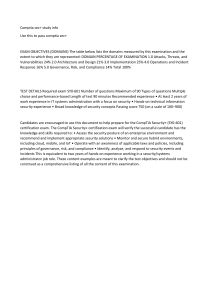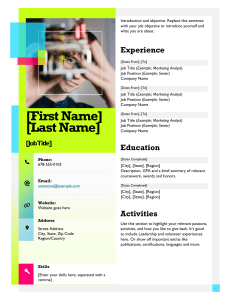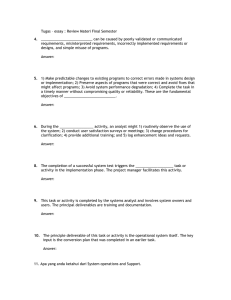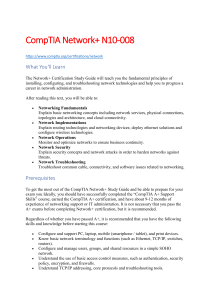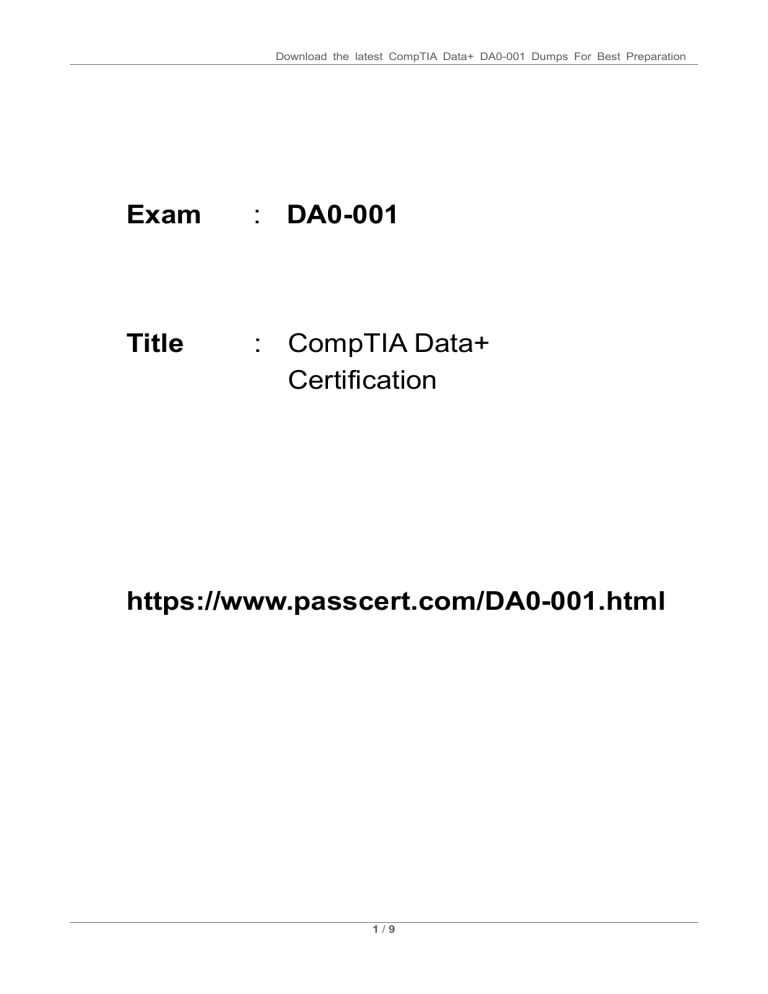
Download the latest CompTIA Data+ DA0-001 Dumps For Best Preparation Exam : DA0-001 Title : CompTIA Data+ Certification https://www.passcert.com/DA0-001.html 1/9 Download the latest CompTIA Data+ DA0-001 Dumps For Best Preparation 1.Refer to the exhibit. A data analyst needs to calculate the mean for Q1 sales using the data set below: Which of the following is the mean? A. $2,466.18 B. $2,667.60 C. $3,082.72 D. $12,330.88 Answer: C Explanation: The mean is the average of all the values in a data set. To calculate the mean, we add up all the values and divide by the number of values. In this case, the mean for Q1 sales is ($2,000 + $3,000 + $4,000 + $2,500 + $3,500) / 5 = $3,082.72 Reference: CompTIA Data+ Certification Exam Objectives, page 9 2.A data analyst is creating a report that will provide information about various regions, products, and time periods. Which of the following formats would be the MOST efficient way to deliver this report? A. A workbook with multiple tabs for each region B. A daily email with snapshots of regional summaries C. A static report with a different page for every filtered view D. A dashboard with filters at the top that the user can toggle Answer: D Explanation: A dashboard with filters at the top that the user can toggle would be the most efficient way to deliver this report, because it allows the user to customize the view and explore different combinations of regions, products, and time periods. A workbook with multiple tabs for each region would be cumbersome and repetitive. A daily email with snapshots of regional summaries would not provide enough detail or interactivity. A static report with a different page for every filtered view would be too long and hard to navigate. Reference: CompTIA Data+ Certification Exam Objectives, page 14 3.Refer to the exhibit. A customer list from a financial services company is shown below: 2/9 Download the latest CompTIA Data+ DA0-001 Dumps For Best Preparation A data analyst wants to create a likely-to-buy score on a scale from 0 to 100, based on an average of the three numerical variables: number of credit cards, age, and income. Which of the following should the analyst do to the variables to ensure they all have the same weight in the score calculation? A. Recode the variables. B. Calculate the percentiles of the variables. C. Calculate the standard deviations of the variables. D. Normalize the variables. Answer: D Explanation: Normalizing the variables means scaling them to a common range, such as 0 to 1 or -1 to 1, so that they have the same weight in the score calculation. Recoding the variables means changing their values or categories, which would alter their meaning and distribution. Calculating the percentiles of the variables means ranking them relative to each other, which would not account for their actual magnitudes. Calculating the standard deviations of the variables means measuring their variability, which would not make them comparable. Reference: CompTIA Data+ Certification Exam Objectives, page 10 4.Which of the following actions should be taken when transmitting data to mitigate the chance of a data leak occurring? (Choose two.) A. Data identification B. Data processing C. Data Reporting D. Data encryption E. Data masking F. Fata removal Answer: DE Explanation: Data encryption and data masking are two actions that can be taken when transmitting data to mitigate the chance of a data leak occurring. Data encryption means transforming data into an unreadable format that can only be decrypted with a key. Data masking means hiding or replacing sensitive data with fictitious or anonymized data. Both methods protect the confidentiality and integrity of the data in transit. Reference: CompTIA Data+ Certification Exam Objectives, page 13 5.A data analyst has been asked to organize the table below in the following ways: By sales from high to low 3/9 Download the latest CompTIA Data+ DA0-001 Dumps For Best Preparation By state in alphabetic order - Which of the following functions will allow the data analyst to organize the table in this manner? A. Conditional formatting B. Grouping C. Filtering D. Sorting Answer: D Explanation: Sorting is the function that will allow the data analyst to organize the table in the desired manner. Sorting means arranging the data in a specific order, such as ascending or descending, based on one or more criteria. Sorting can be applied to any column in the table, such as sales or state. Reference: CompTIA Data+ Certification Exam Objectives, page 11 6.Which of the following BEST describes the issue in which character values are mixed with integer values in a data set column? A. Duplicate data B. Missing data C. Data outliers D. Invalid data type Answer: D Explanation: The invalid data type is the best description for the issue in which character values are mixed with integer values in a data set column. Invalid data type means that the data does not match the expected or required format or structure for a given variable or attribute. For example, if a column is supposed to store numerical values, but some rows contain text values, then those rows have an invalid data type. Reference: CompTIA Data+ Certification Exam Objectives, page 10 7.Which of the following is a process that is used during data integration to collect, blend, and load data? A. MDM B. ETL C. OLTP D. BI Answer: B Explanation: ETL is a process that is used during data integration to collect, blend, and load data. ETL stands for extract, transform, and load, which are the three main steps involved in moving data from different 4/9 Download the latest CompTIA Data+ DA0-001 Dumps For Best Preparation sources to a common destination, such as a data warehouse or a data lake. ETL helps to consolidate and standardize data for analysis and reporting purposes. Reference: CompTIA Data+ Certification Exam Objectives, page 12 8.An analyst has received the requirements for an internal user dashboard. The analyst confirms the data sources and then creates a wireframe. Which of the following is the NEXT step the analyst should take in the dashboard creation process? A. Optimize the dashboard. B. Create subscriptions. C. Get stakeholder approval. D. Deploy to production. Answer: C Explanation: Getting stakeholder approval is the next step the analyst should take in the dashboard creation process, after confirming the data sources and creating a wireframe. Stakeholder approval means getting feedback and validation from the intended users or clients of the dashboard, to ensure that it meets their expectations and requirements. This step helps to avoid rework and ensure customer satisfaction. Reference: CompTIA Data+ Certification Exam Objectives, page 14 9.A data analyst has been asked to derive a new variable labeled “Promotion_flag” based on the total quantity sold by each salesperson. Given the table below: Which of the following functions would the analyst consider appropriate to flag “Yes” for every salesperson who has a number above 1,000,000 in the Quantity_sold column? A. Date B. Mathematical C. Logical D. Aggregate Answer: C Explanation: A logical function is a type of function that returns a value based on a condition or a set of conditions. For 5/9 Download the latest CompTIA Data+ DA0-001 Dumps For Best Preparation example, the IF function in Excel can be used to check if a certain condition is met, and then return one value if true, and another value if false. In this case, the data analyst can use a logical function to check if the Quantity_sold column is greater than 1,000,000, and then return “Yes” if true, and “No” if false. This would create a new variable called Promotion_flag that indicates whether the salesperson has sold more than 1,000,000 units or not. Reference: CompTIA Data+ Certification Exam Objectives, Logical functions (reference) 10.Refer to the exhibit. Given the diagram below: Which of the following data schemas shown? A. Key-value pairs B. Online transactional processing C. Data Lake D. Relational database Answer: D Explanation: A relational database is a type of database that organizes data into tables, where each table has a fixed number of columns and a variable number of rows. Each row in a table represents a record or an entity, and each column represents an attribute or a property of that entity. The tables are linked by common fields, called keys, which enable the database to establish relationships between the data. A relational database schema is a diagram that shows the structure and organization of the tables, columns, keys, and constraints in a relational database. The diagram given in the question is an example of a relational database schema, as it shows two tables: “Runs” and “Experiments”, with their respective columns, data types, and primary keys. The “Runs” table also has a foreign key that references the “ExperimentId” column in the “Experiments” table, indicating a relationship between the two tables. Therefore, the correct answer is D. Reference: What is a database schema? | IBM, Database Schema - Javatpoint 11.A company’s marketing department wants to do a promotional campaign next month. A data analyst on the team has been asked to perform customer segmentation, looking at how recently a customer bought the product, at what frequency, and at what value. Which of the following types of analysis would this practice be considered? A. Prescriptive B. Trend 6/9 Download the latest CompTIA Data+ DA0-001 Dumps For Best Preparation C. Gap D. Custer Answer: D Explanation: Customer segmentation is a type of cluster analysis, which is a method of grouping data points based on their similarities or differences. Cluster analysis can help identify patterns and trends in the data, as well as target specific groups of customers for marketing purposes. One common technique for customer segmentation is RFM analysis, which stands for recency, frequency, and monetary value. This technique assigns a score to each customer based on how recently they bought the product, how often they buy the product, and how much they spend on the product. These scores can then be used to create clusters of customers with different characteristics and preferences. Therefore, the correct answer is D. Reference: Cluster Analysis - Statistics Solutions, RFM Analysis: The Ultimate Guide for Customer Segmentation 12.A publishing group has requested a dashboard to track submissions before publication. A key requirement is that all changes are tracked, as multiple users will be checking out documents and editing them before submissions are considered final. Which of the following is the BEST way to meet this stakeholder requirement? A. Display the version number next to each submission on the dashboard. B. Present a data refresh date at the top of the dashboard. C. Confirm the dashboard is adhering to the corporate style guide. D. Use permissions to ensure users only see certain versions of the submissions. Answer: A Explanation: A static report is a type of report that shows a snapshot of data at a specific point in time. A static report does not change or update automatically, unless the data source is refreshed or the report is regenerated. A static report is suitable for situations where the data does not change frequently or where historical data is needed for comparison or analysis. In this case, the data analyst is asked to create a sales report for the second-quarter 2020 board meeting, which will include a review of the business’s performance through the second quarter. The board meeting will be held on July 15, 2020, after the numbers are finalized. This means that the data analyst does not need to show real-time or dynamic data, but rather a fixed and accurate view of the sales data for the second quarter. Therefore, a static report would be the best way to meet this stakeholder requirement. Therefore, the correct answer is A. Reference: What are Static Reports? | Sisense, Static vs Dynamic Reports - What’s The Difference? | datapine 13.The number of phone calls that the call center receives in a day is an example of: A. continuous data. B. categorical data. C. ordinal data. D. discrete data. Answer: D Explanation: Discrete data is a type of data that can only take certain values, usually whole numbers or integers. 7/9 Download the latest CompTIA Data+ DA0-001 Dumps For Best Preparation Discrete data can be counted, but not measured. For example, the number of students in a class, the number of books in a library, or the number of phone calls that a call center receives in a day are all examples of discrete data. Discrete data is different from continuous data, which can take any value within a range, and can be measured with precision. For example, the height of a person, the weight of a fruit, or the temperature of a room are all examples of continuous data. Therefore, the correct answer is D. Reference: [Discrete vs Continuous Data: Definition and Examples - Statistics How To], [Discrete Data Definition and Examples | Math Goodies] 14.A data analyst is asked to create a sales report for the second-quarter 2020 board meeting, which will include a review of the business’s performance through the second quarter. The board meeting will be held on July 15, 2020, after the numbers are finalized. Which of the following report types should the data analyst create? A. Static B. Real-time C. Self-service D. Dynamic Answer: A Explanation: A dynamic report is a type of report that shows data that changes or updates automatically based on certain criteria or parameters. A dynamic report can allow users to interact with the data, filter it, drill down into it, or visualize it in different ways. A dynamic report is suitable for situations where the data changes frequently or where real-time or near-real-time data is needed for decision making or analysis. In this case, the data analyst is asked to create a sales report for the second-quarter 2020 board meeting, which will include a review of the business’s performance through the second quarter. The board meeting will be held on July 15, 2020, after the numbers are finalized. This means that the data analyst does not need to show real-time or dynamic data, but rather a fixed and accurate view of the sales data for the second quarter. Therefore, a static report would be the best way to meet this stakeholder requirement. Therefore, the correct answer is A. Reference: [What are Dynamic Reports? | Sisense], Static vs Dynamic Reports - What’s The Difference? | datapine 15.Which of the following would be considered non-personally identifiable information? A. Cell phone device name B. Customer’s name C. Government ID number D. Telephone number Answer: A Explanation: Non-personally identifiable information (non-PII) is any data that cannot be used to identify, contact, or locate a specific individual, either alone or combined with other sources. Non-PII can include aggregated statistics, anonymous data, device identifiers, IP addresses, cookies, and other types of information that do not reveal the identity or location of a person. Cell phone device name is an example of non-PII, as it does not reveal any personal information about the owner or user of the device. Therefore, the correct answer is A. 8/9 Download the latest CompTIA Data+ DA0-001 Dumps For Best Preparation Reference: What is Non-Personally Identifiable Information (Non-PII)? | Definition and Examples, What is Personally Identifiable Information (PII)? | Definition and Examples 16.Which of the following is the correct data type for text? A. Boolean B. String C. Integer D. Float Answer: B Explanation: A string is a data type that represents a sequence of characters, such as text, symbols, numbers, or punctuation marks. Strings are enclosed in quotation marks, such as “Hello”, “123”, or “!@#”. Strings can be manipulated, concatenated, sliced, indexed, formatted, and searched using various methods and functions. A string is different from other data types, such as boolean, integer, or float, which represent logical values (true or false), whole numbers, or decimal numbers respectively. Therefore, the correct answer is B. Reference: What is a String? | Definition and Examples, Python String Methods 17.Which of the following should be accomplished NEXT after understanding a business requirement for a data analysis report? A. Rephrase the business requirement. B. Determine the data necessary for the analysis. C. Build a mock dashboard/presentation layout. D. Perform exploratory data analysis. Answer: B Explanation: Exploratory data analysis (EDA) is a process of examining and summarizing a dataset using various techniques, such as descriptive statistics, visualizations, correlations, outliers detection, and hypothesis testing. EDA can help reveal the main characteristics, patterns, trends, and insights from the data, as well as identify any problems or issues with the data quality or structure. EDA is usually performed after understanding a business requirement for a data analysis report and before building a mock dashboard/presentation layout. Therefore, the correct answer is B. Reference: [What is Exploratory Data Analysis? | Definition and Examples], [Exploratory Data Analysis in Python] 18.Which of the following is a common data analytics tool that is also used as an interpreted, high-level, general-purpose programming language? A. SAS B. Microsoft Power BI C. IBM SPSS D. Python Answer: D 9/9


